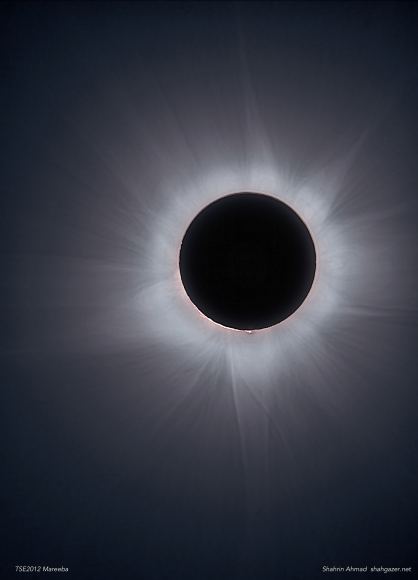
It’s hard to believe: we’re now just one short weekend away from the big ticket astronomical event for 2017, as a total solar eclipse is set to cross over the contiguous United States on Monday, August 21st.
Celestial mechanics is a sure thing in this Universe, a certainty along with death and taxes that you can bet on. But there are still a few key question marks leading up to eclipse day, things that we can now finally make intelligent assumptions about a few days out.
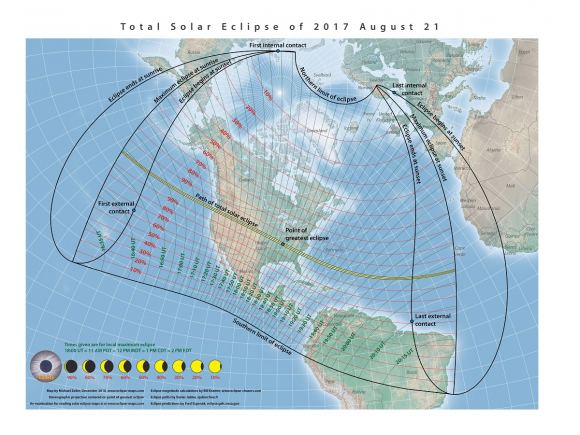
First up is solar activity. If you’re like us, you’ll be showing off the Sun in both visible and hydrogen alpha as the Moon begins making its slow hour long creep across the disk of Sol. First, the good news: sunspot active region AR 2671 made its Earthward debut on Tuesday August 15th, and will most likely stick around until eclipse day. The bad news is, it most likely won’t have lots of friends, as solar cycle #24 begins its long slow ebb towards the solar minimum in 2019-2020. Likewise, I wouldn’t expect to see any magnificent sprouting red prominences in the solar chromosphere in the seconds bracketing totality, though we could always be pleasantly surprised.
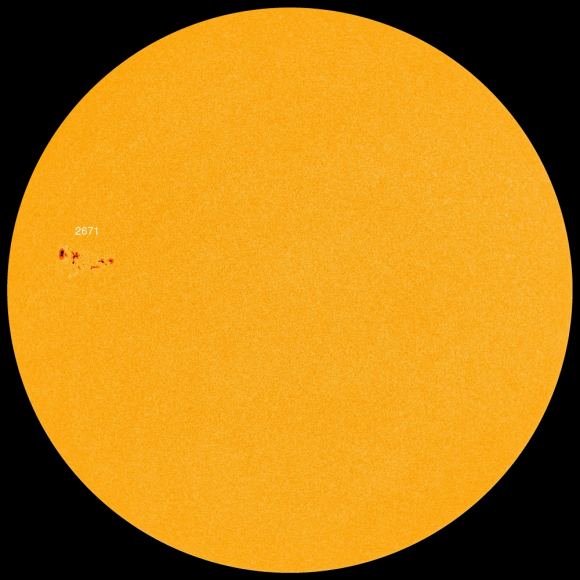
How will the white hot corona appear during totality? This is the signature climax of any total solar eclipse: veteran umbraphiles can actually glance at a photo of totality and tell you which eclipse it was from, just on the shape of the corona. The National Solar Observatory released a model of what that Sun’s magnetosphere was doing one Carrington rotation (27 days) prior to the eclipse on July 25th, a pretty good predictor of the corona might look like during those fleeting moments of totality:
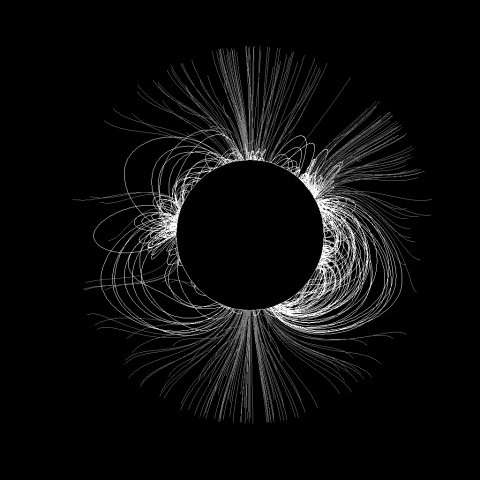
NASA will be chasing the umbra of the Moon with two converted W-57 aircraft during the eclipse, hoping to unlock the “coronal heating paradox,” image Mercury in the infrared, and hunt for elusive Vulcanoid asteroids near the eclipsed Sun.
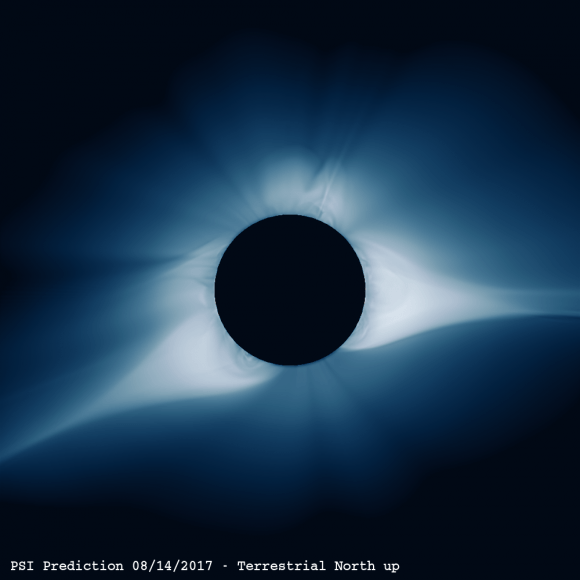
The corona is about twice as bright as a Full Moon, and its interface with the solar wind extends out past the Earth. The very onset of totality is like the footstep of a giant passing over the landscape, as the door of reality is suddenly ripped open, revealing the span of the glittering solar system at midday. Keep your eyes peeled for Mercury, Venus, Mars, Jupiter and twinkling Regulus tangled up in the corona, just a degree from the Sun-Moon pair:
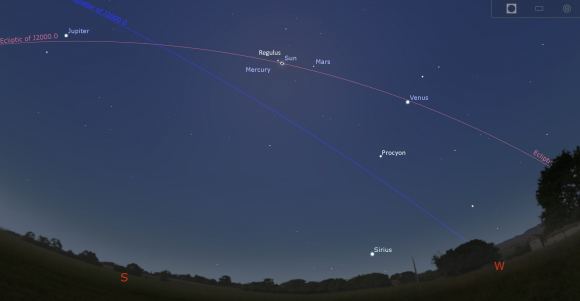
Also, be sure to scan the local horizon for a strange 360 degree sunset as you stand in the umbra of the Moon. An “eclipse wind” may kick up, as temperatures plummet and nature is fooled by the false dawn, causing chickens to come home to roost and nocturnal animals to awaken. I dare you to blink. Totality can affect the human heart as well, causing tears to cries of surprise.
Here’s an interesting, though remote, possibility. Could a sungrazing “eclipse comet” photo bomb the show? Karl Battams (@SungrazerComets) raises this question on a recent Planetary Society blog post. Battams works with the Solar Heliospheric Observatory (SOHO), which has discovered an amazing 3,358 comets crossing the field of view of its LASCO imagers since 1995. Comets have been discovered during eclipses before, most notably in 1882 and 1948. To be sure, it’s a remote possibility this late in the game, but Battams promises to give us one last quick look via SOHO the morning of the eclipse on his Twitter feed to see if any cometary interlopers are afoot.
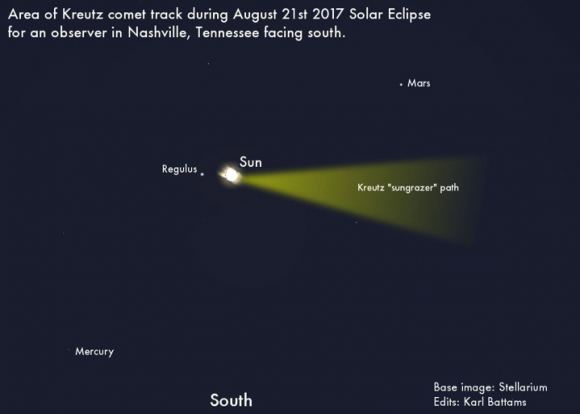
Now, on to the biggest question mark going into this eclipse weekend: what’s the weather going to be like during the eclipse? This is the ever-dominating factor on everyone’s mind leading up to eclipse day. Keep in mind, the partial phases are long; even a partly cloudy sky will afford occasional glimpses of the Sun during the partial phases of an eclipse. Totality, however, is fleeting – 2 minutes and 40 seconds near Hopkinsville, Kentucky and less for most – meaning even a solitary cumulus cloud drifting across the Sun at the wrong moment can spoil the view. No weather model can predict the view of the sky to that refined a level. And while best bets are still out west, lingering forest fires in Oregon are a concern, along early morning fog on the western side of the Cascade Mountains. Michael Zeiler over at The Great American Eclipse has been providing ESRI models of the cloud cover over the eclipse path for Monday… here’s the outlook as of Thursday, August 17th:
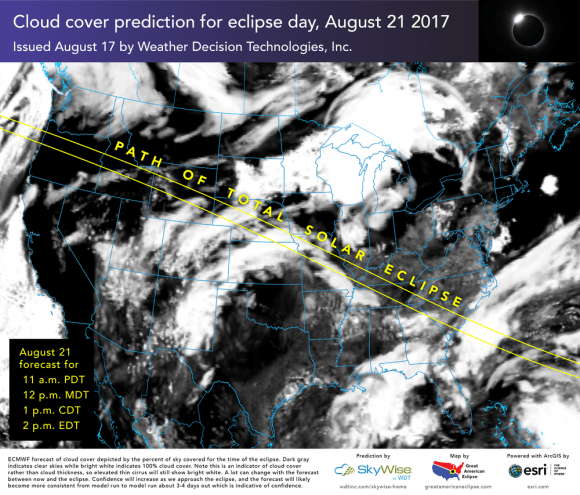
Computer models should begin to come into agreement this weekend, a good sign that we know what the weather is going to do Monday. Needless to say, a deviation from the standard climate models could send lots of folks scrambling down the path at the last minute… I’ve heard of folks with up to 5 (!) separate reservations along the path of totality, no lie…
The NOAA also has a fine site dedicated to weather and cloud coverage across the path come eclipse day, and Skippy Sky is another great resource aimed at sky viewing and cloud cover.
Clouded out? The good folks at the Virtual Telescope have got you covered, with a webcast for the total solar eclipse starting at 17:00 UT/1:00 PM EDT:
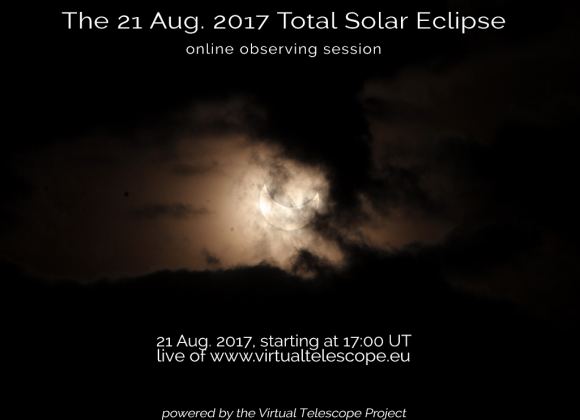
Of course, you’ll need to use proper solar viewing methods during all partial phases of the eclipse. This means either using a telescope with a filter specifically designed to look at the Sun, a pin hole projector, or certified ISO 12312-2 eclipse glasses. If you’ve got an extra pair, why not convert them into a safe filter for those binoculars or a small telescope as well:
Also be wary of heatstroke, standing out showing folks the partially eclipsed Sun for an hour or more. It is August, and heat exhaustion can come on in a hurry. Be sure you have access to shade and stay cool and hydrated in the summer Sun.
Finally, eyes from space will be watching the eclipse from the International Space Station as well. Looking out at Monday, the ISS will pass through the penumbra of the Moon and see partial phases of the eclipse three times centered on 16:32, 18:20, and 20:00 Universal Time. The center time is particularly intriguing, as astros have a chance to see the dark umbral shadow of the Moon crossing the central U.S. This also means that eclipse viewers on planet Earth around southern Illinois might want to glance northward briefly, to spy the ISS during totality. Also, viewers along a line along southern central Canada will have a chance to catch an ISS transit across the face of the partially eclipsed Sun around the same time. Check CALSky for details.

We’ll be at the Pisgah Astronomical Research Institute in southwestern North Carolina, for a glorious 104 seconds of totality. We expect to be out of wifi range come eclipse day, but we’ll tweet out key eclipse milestones as @Astroguyz. We also plan on writing up the eclipse experience with state-by-state testimonials post eclipse.
Perhaps, the August 21st total solar eclipse will bring us all together for one brief moment, to witness the grandest of astronomical spectacles. We’re lucky to share a small patch of time and space where total solar eclipses are possible. Good luck, clear skies, and see you on the other side early next week!
- Read more about the August 21st total solar eclipse and the true tale of Edison’s chickens and the 1878 eclipse in our free e-book: 101 Astronomical Events for 2017.
- The oldest video featuring totality? Read the mystery of the August 21st, 1914 over war torn Europe and this amazing video over Sweden.
- Eclipse… sci-fi? Read our original eclipse-fueled tales Exeligmos, Shadowfall, Peak Season and more.
- Read our CNN Op-Ed, Why We Chase Eclipses.


Oh no. Just had to say it. While packing my 2′ reflector telescope for a 45 minute trip to watch the solar eclipse in TN, My telescope was damaged. I now have basically over the weekend to try and repair the damage. Oh I was going to have wonderful camera shots of the eclipse all through it’s cycle. So, I hope somebody can post theirs. This would have been the first eclipse of my new camera.